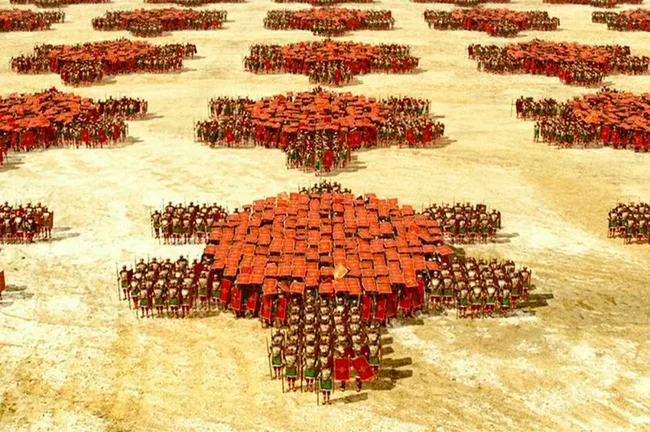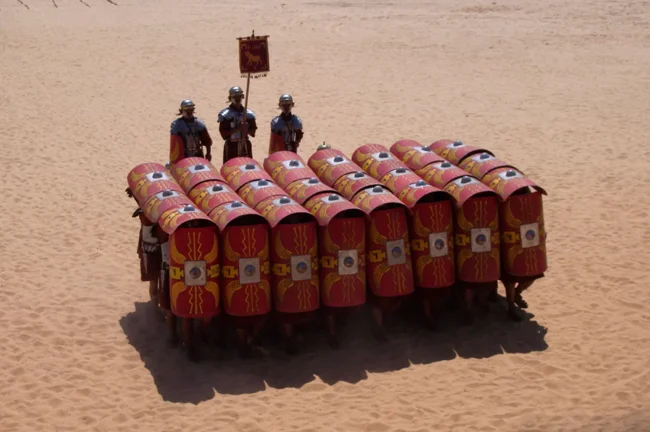The “Turtle” is perhaps the most recognizable battle formation of the Roman infantry, which for many centuries provided the legion with convincing victories over foreign armies. 
How reliable was the formation, and what techniques did the enemies of Rome use to fight the “turtle”?
“Courage replaces walls” (Roman proverb)
The formation was used to protect soldiers from throwing weapons in open battle and when storming fortifications.
At the officer’s command, the first row of legionnaires closed their shields, turning them towards the front. At the same time, the second and subsequent rows raised the shields above themselves, resting their heads against them for balance. At the same time, the edges of the shields overlapped each other, covering the gaps and creating a semblance of a tiled roof.
If necessary, the outermost legionnaires in each row put their shields outward to protect the flanks, and the last row turned its back to the front, moving back and covering the rear.
According to the ancient Roman writer Dio Cassius, the formation easily supported a chariot with a driver and made the fighters practically invulnerable at a distance.
From the point of view of the English historian Peter Connolly, it was possible to build a “turtle” from any number of soldiers.
During the assault on the fortress walls, the fighters placed a “turtle” on top of each other, creating a semblance of steps along which the assault squad climbed the fortification.
How did the barbarians fight the Roman tortoise?
Contrary to popular belief, the “turtle” was not a universal construction and had many disadvantages.
In particular, the need for soldiers to maintain formation made them extremely slow and clumsy. In addition, the cramped space did not provide space for fencing, and an attempt to open the shield to strike would endanger a neighbor. 
The Turtle was extremely vulnerable to spearmen, heavy cavalry and throwing vehicles. The cataphract and phalanx broke the battle formation, making the legionnaires in the front row an easy target for archers, especially those on horseback.
The enemies of Rome took advantage of this, making repeated cavalry attacks and throwing arrows at the exposed legionnaires.
The most revealing in this regard are two unsuccessful Roman campaigns in the Middle East: Marcus Crassus in 53 BC. and Mark Antony in 36 BC.
“What is forgiven to Jupiter is not forgiven to man” (Roman proverb)
Marcus Crassus, leading 7 legions and 8 thousand auxiliary troops, invaded the Parthian kingdom, torn apart by civil war. Suren Mikhran undertook to defend the East with ten thousand horse archers and a thousand cataphracts.
The battle broke out on the border of modern Turkey and Syria near the city of Harran. The Parthians killed the Roman cavalry, surrounded the legionnaires, who lined up like a turtle, and methodically shot them with armor-piercing arrows.
Long and heavy metal arrowheads got stuck in the wooden panel of the shields, but thanks to the cataphracts, who broke the formation, they easily pierced the armor. Suffering from thirst and fatigue, the legions began to slowly break through to the nearby city. During the retreat, the Romans lost half the army killed, including Crassus himself.
Mark Antony, a comrade-in-arms of Julius Caesar, was more successful. The commander stayed close to sources of water and food, covered his rear and managed to capture several key Parthian cities.
True, Anthony lost a third of his men and all his siege engines. At the same time, the losses of the Parthians, who carried out the “Scythian tactics” of the war, turned out to be minimal. Unable to continue the campaign, the leader concluded a truce and left the previously captured territories.
0 comments
